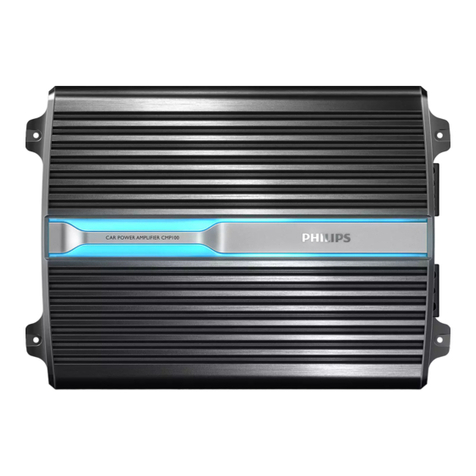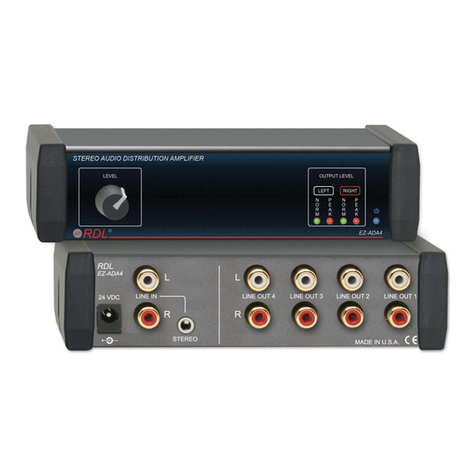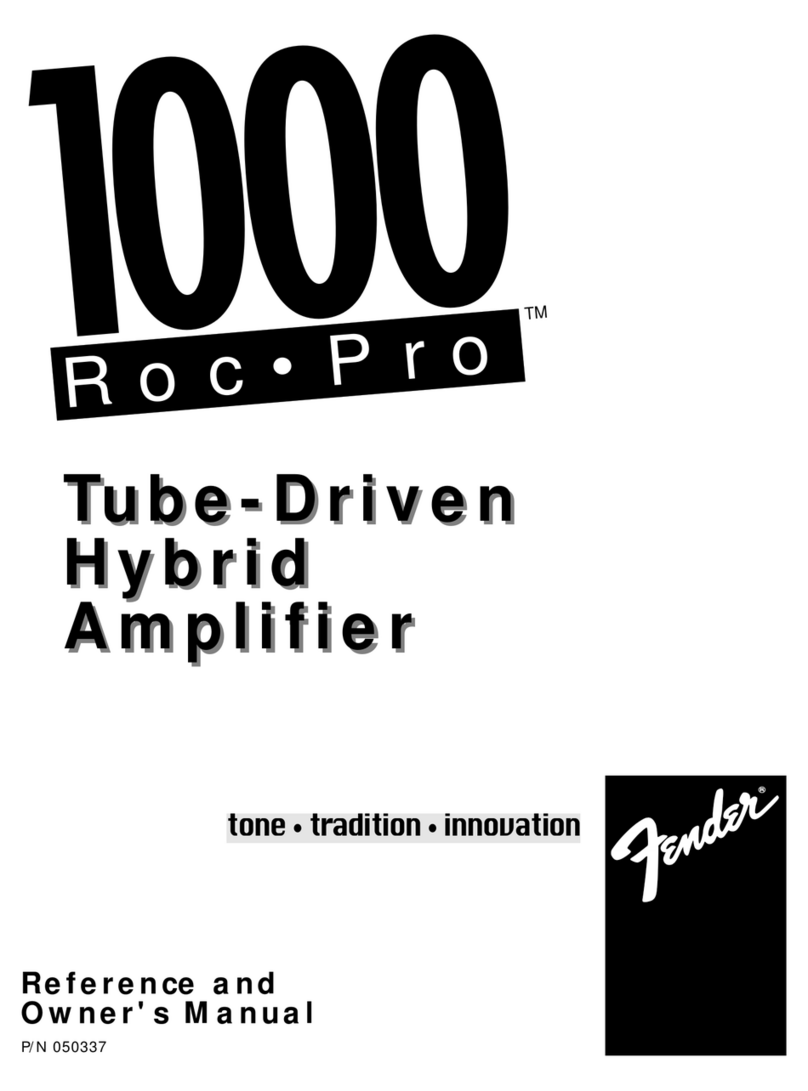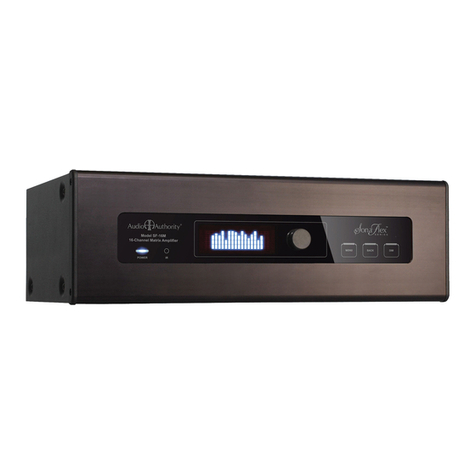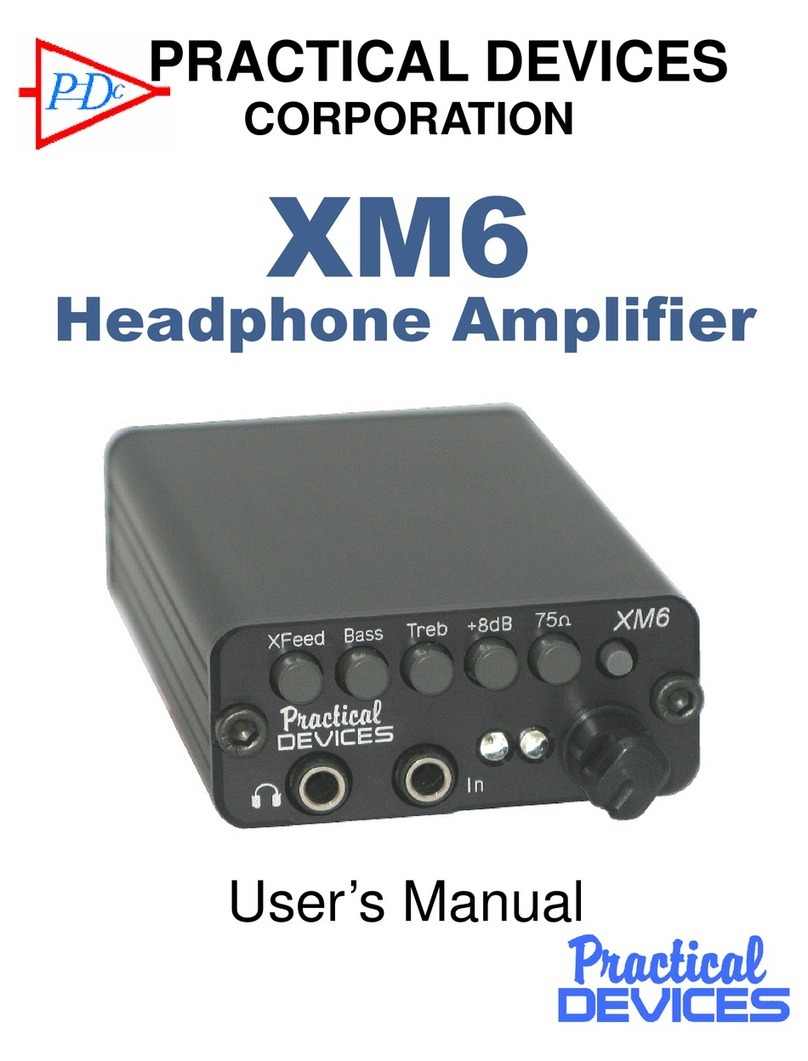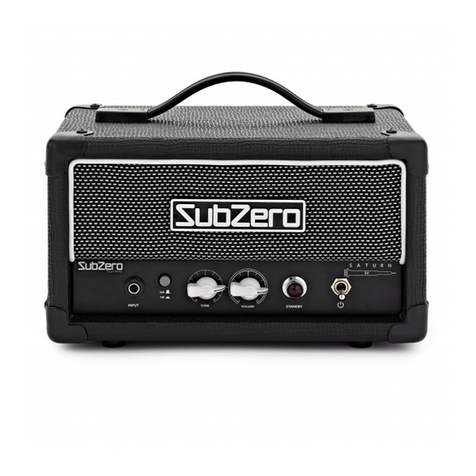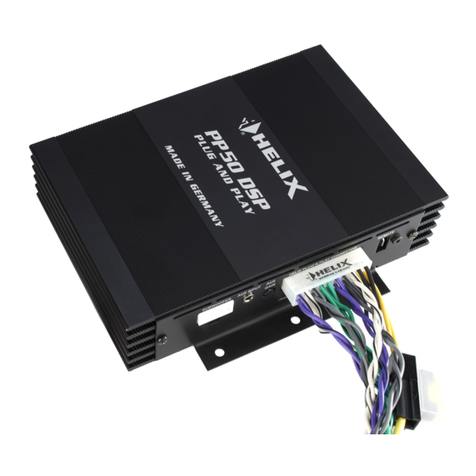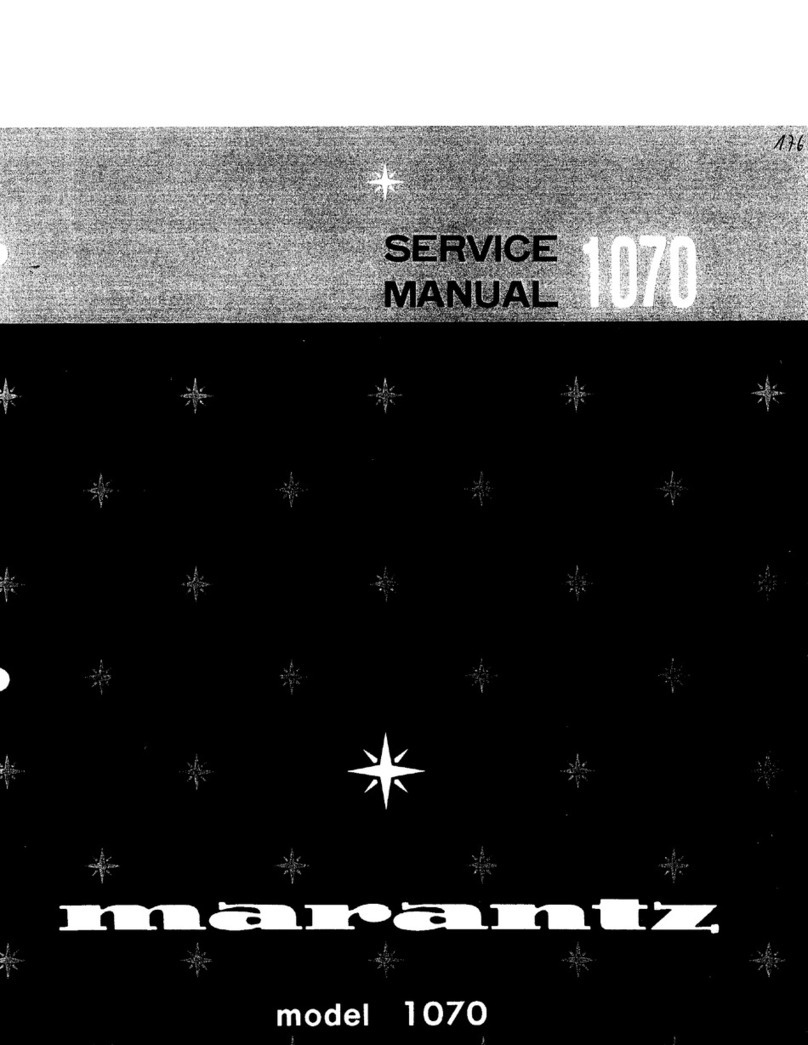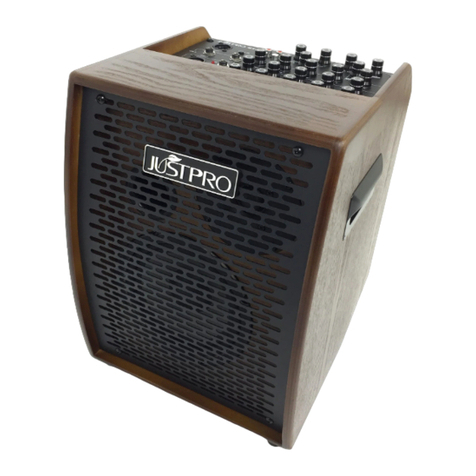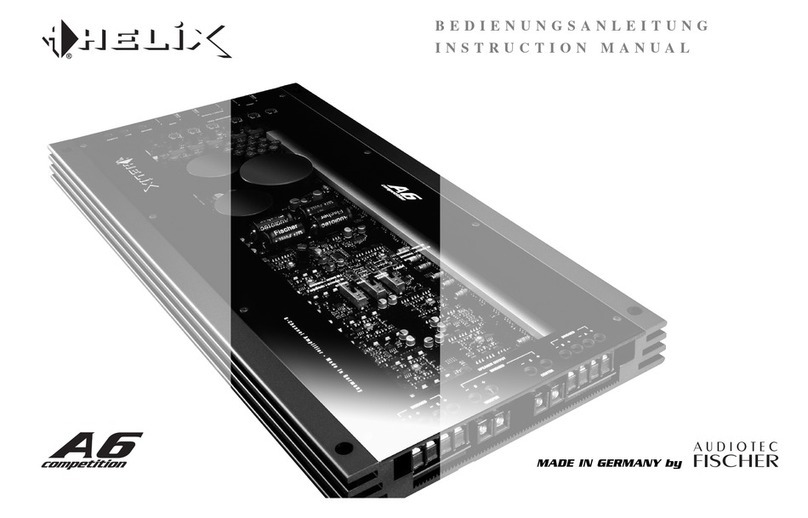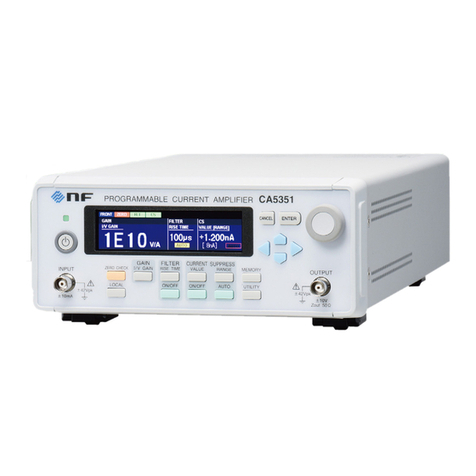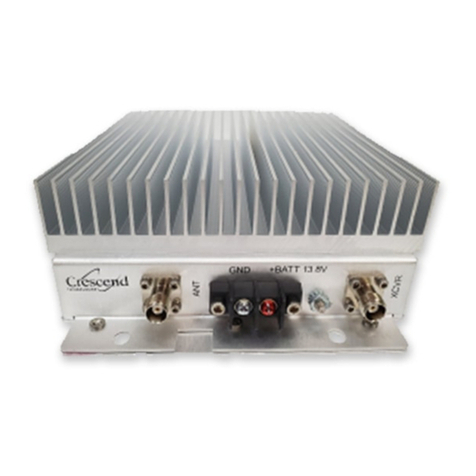Tone King Metropolitan User manual

Tone King “Metropolitan”
Tone King “Metropolitan”Tone King “Metropolitan”
Tone King “Metropolitan”
User’s Manual
User’s ManualUser’s Manual
User’s Manual
R1.4 8/25/2015
Tone King Amplifier Company, Inc.
4401 Eastern Avenue, Bldg 4 -3G, Box 38
Baltimore, Maryland 21224
www.toneking.com
mail@toneking.com

1
Note from the Builder
Note from the BuilderNote from the Builder
Note from the Builder
Thank you for choosing this Tone King Metropolitan guitar amplifier. The Metropolitan
is the last in a line of amplifiers, starting with the Meteor, and then the Meteor II, which
add modern qualities to the vintage sounds explored with the older models, such as the
Imperial and Comet. The idea was to retain those same great vintage tones, ut to add
refinements such as more clarity and detail, a more room-filling, three-dimensional
soundfield, and certain features to provide more flexi ility.
One of these features is the new “Phase-4” Output Power Control Circuitry. This
proprietary circuit allows control over the amount of power produced y the output
stage, allowing you to o tain overdriven sounds at lower volume. This unique circuit
operates differently than an attenuator, master volume, power scaling, or any other
scheme that I am aware of. It is a particularly good match for the Metropolitan, which
is intended as a more modern take on vintage sound, ecause it reduced power supply
sag as you reduce the output power, resulting in a more powerful attack.
I’ve composed this User’s Manual as a means of descri ing the features and operation
of the Metropolitan. If you have any questions which are not covered here, please feel
free to contact me personally at mail@toneking.com.
Mark Bartel
Tone King Amplfiers
Contents
ContentsContents
Contents
1. Front Panel Controls 2
Gain Switch 2
Rhythm Channel 2
Lead Channel 3
Channel Switching 4
Rever 5
Output Power Controls 5
2. Back Panel Controls 7
AC Power 7
Fuse 7
Power Switch, Stand y Switch 7
Footswitch 7
Speaker Jacks, Impedance Switch 8
3. Tube Installation and Replacement 9
Installing Tu es 9
Choice of Tu e Types and Brands 9
Tu e Quality 11
4. Warranty 12

2
1. Front Panel Controls
1. Front Panel Controls1. Front Panel Controls
1. Front Panel Controls
Gain Switch
Gain SwitchGain Switch
Gain Switch
The Gain switch controls the gain of the first stage of the preamp, which is shared
etween the Rhythm and Lead channels. Thus, it acts as a glo al gain control which
helps match the overall gain level to the output level of your guitar’s pickups.
I almost always suggest using the high gain setting, unless you have particularly high
output pickups, or you want a lot of headroom. The higher gain setting seems to give
the amp more punch, a faster attack, and more clarity.
Note that you will hear an audi le “thump” when you switch etween the two gain
settings. This thump is a result of the switch acting on a very sensitive part of the
circuit. Any means of reducing the thump would degrade the purity of the signal path,
so it was decided that it was est to allow the thump, and maintain the pure signal
path. This is generally not a pro lem, as you will typically find that you’ll use one
setting or the other with a given guitar, no matter how the two channels are dialed in.
You may want to turn the volume control down all the way (on the selected channel)
when switching etween gain settings, to eliminate the “thump”.
Rhythm Channel
Rhythm ChannelRhythm Channel
Rhythm Channel
The Rhythm channel includes controls for Volume, Tre le, and Bass, as well as a
“Bright” switch. This channel is voiced somewhere etween a typical “ lackface”
preamp and a typical “tweed” preamp, and has a wider range of tones than either of
those preamp types.
A typical “ lackface” preamp can e quite lean in the midrange, which can give you a
deep, lush sound when playing in isolation, ut this type of voicing can get drowned out
and sound thin when played in a and situation.
A typical “Tweed” preamp has a sweet and vocal midrange, ut can tend to sound oxy
on clean tones.
The Metropolitan’s Rhythm channel preamp straddles the line etween these two
preamp types. With the ass and tre le controls set to their nominal values, you’ll get
a clean tone that com ines a prominent and present midrange with a lush and
shimmering overall response.

3
Rhythm Channel Cont’d)
Rhythm Channel Cont’d)Rhythm Channel Cont’d)
Rhythm Channel Cont’d)
Getting to Know the Bass and Treble Controls
You’ll notice that the Bass and Tre le controls affect the tone quite differently than the
Bass and Tre le controls of a conventional “ lackface” style preamp. With a typical
“ lackface” preamp, the Bass and Tre le controls simply give you a different flavor of
the same asic tone.
The Metropolitan’s Bass and Tre le controls have a more prominent effect - they alter
the actual voicing and character of the tone. Because of this, you should experiment
with them fully to understand their effect on the Rhythm’s channel’s overall voicing.
Although the Rhythm channel has no midrange control, it offers more flexi ility than
most similar preamps, even those which include a midrange control, ecause of the way
the Bass and Tre le controls transform the overall character and voicing.
Here are a few sample settings. You may want to start with these settings and tweak
the ass and tre le controls to taste.
Blackface Clean with Tweed Mids
Blackface Clean with Tweed MidsBlackface Clean with Tweed Mids
Blackface Clean with Tweed Mids
Gain Volume Bright Treble Bass
High 1.5 Off 5 6
Traditional Blackface Clean with Scooped Mids
Traditional Blackface Clean with Scooped MidsTraditional Blackface Clean with Scooped Mids
Traditional Blackface Clean with Scooped Mids
Gain Volume Bright Treble Bass
High 1.5 On 4 8
Lead Channel
Lead ChannelLead Channel
Lead Channel
The Lead channel starts out with a Tweed style preamp, which drives a proprietary
tone-shaping circuit uilt around the Mid-Bite control, a unique Tone King feature.
This proprietary circuit transforms the asic tweed tone to more of a crunchy rock tone
as you turn up the mid- ite control. This is accomplished y simultaneously tightening
up the ass, rolling off the very high frequencies, increasing the gain, and developing a
pronounced upper midrange peak. The Mid-Bite control is the key to dialing in your
own particular sound on the lead channel, so you may want to experiment and o serve
its effect as you rotate it from 0 to 10.

4
Lead Channel Cont’d)
Lead Channel Cont’d)Lead Channel Cont’d)
Lead Channel Cont’d)
Here are a few sample settings which demonstrate just a few of the tones availa le on
the lead channel:
Tweed Edge of Breakup
Tweed Edge of BreakupTweed Edge of Breakup
Tweed Edge of Breakup
Gain Volume Tone Mid-Bite
Low 4 7 0.5
Cranked Tweed
Cranked TweedCranked Tweed
Cranked Tweed
Gain Volume Tone Mid-Bite
High 4 5 3
Rock Grind
Rock GrindRock Grind
Rock Grind
Gain Volume Tone Mid-Bite
High 2 6 9
Hard Rock Gainy G
Hard Rock Gainy GHard Rock Gainy G
Hard Rock Gainy Grind
rindrind
rind
Gain Volume Tone Mid-Bite
High 4 7 10
Channel Switching
Channel SwitchingChannel Switching
Channel Switching
You can switch etween the two preamp channels with either the front panel Channel
switch, or y using the footswitch.
When using the footswitch, make sure that the front panel Channel switch is in the
Rhythm position.
When using the footswitch, you’ll notice that the LED on the footswitch indicates the
channel selected. When the LED is lit, the Lead channel is selected. When the LED is
not lit, the Rhythm channel is selected.

5
Reverb
ReverbReverb
Reverb
The Metropolitan includes a uilt in 3-spring, tu e-driven rever circuit. Rever is
applied to oth the Rhythm and Lead channels. In order to compensate for the higher
gain of the Lead channel, the rever drive is reduced slightly on the Lead channel. This
reduction helps to match the rever level when switching etween preamp channels,
with just slightly more rever on the Rhythm channel.
The rever level is controlled y the front panel Rever control, which adjusts the
amount of the rever signal, from the rever receiver, which is mixed into the signal
path.
The footswitch provides the a ility to turn the rever drive on and off. An LED on the
footswitch indicates whether the rever drive is on (LED on) or off (LED off).
When the footswitch is not plugged into the amp, the rever circuit is always active. In
this case, if you don’t want to use the rever effect, then you should turn the rever
control down to 0.
Output Power Controls
Output Power ControlsOutput Power Controls
Output Power Controls
The Output Power controls give you unparalleled control over the tone and volume of
your amp. These controls determine the actual output power produced y the power
tu es of your amp, via Tone King’s proprietary Phase-4 Power Control circuitry.
Separate Output Power controls are provided for the Rhythm and Lead channels. The
following diagram shows the approximate output power at various settings of the
Output Power controls:
Output Power on the Rhythm Channel
On the Rhythm channel, I suggest always using full power (Output Power = 10) for
clean tones, regardless of how loud you are playing. It’s always est to have the
most possi le headroom for a good clean tone, even if you are only playing at very low
volume. For clean tones at low volume, you may find it necessary to use the low gain
preamp setting, and to set the volume control down quite low, ut you should use the
full output power setting for maximum clarity and dynamics.

6
Output Power Controls Cont’d)
Output Power Controls Cont’d)Output Power Controls Cont’d)
Output Power Controls Cont’d)
The only case in which I suggest using a lower power setting on the Rhythm channel is
that in which you are pushing the Rhythm channel harder, for some edge and reakup.
Naturally, the only way to control the volume in this situation is to turn down the
Output Power control.
Output Power on the Lead Channel
The Lead channel is primarily designed for overdriven and distorted sounds, and this is
where the Output Power controls ecome essential for controlling the volume of your
amp. In general, it’s est to use the highest output power setting possi le for your
playing situation, ecause of the factors mentioned elow.
General Notes on Using the Output Power Controls
Although the Phase-4 Power Control circuitry does the est possi le jo of reducing
output power without changing the tone of the amp’s circuitry, there are other varia les
in play at lower volume which do result in some apparent tone change. Here are a few
factors that you should e aware of -
Speaker reakup and compression is a ig part of the tone and feel of the amp when
played at high volume. At low power settings, the speaker responds differently, and
does not reak up and compress as it does at high power.
The ear’s natural response curve varies at different volume levels, which changes the
way you perceive sounds at different volume levels. Quieter sounds tend to give the
impression of having less ass content.
One way to help compensate for the a ove two factors is to intentionally mismatch the
speaker impedance, via the impedance switch on the ack panel. At low power settings
(1W or elow), you might try switching the impedance switch to the 4-ohm position (it
should normally e set to 8-ohms). Doing this will give you a fatter, thicker, slightly
more elastic tone. The downside is that it also tends to roll off the high frequencies a
it as well.
At lower volume, there is a tendency to hit the guitar strings harder and play more
aggressively than you would if the amp were tuned up very loud. It may take some time
to get used to maintaining your playing style at reduced volume.

7
2. Back Panel Controls
2. Back Panel Controls2. Back Panel Controls
2. Back Panel Controls
AC Power
AC PowerAC Power
AC Power
Always use a grounded AC cord, and make sure that a proper ground connection is
supplied to the amp. Never attempt to lift or defeat the ground connection to the amp.
Fuse
FuseFuse
Fuse
A standard 2A fuse (style 3AG) should e used.
Power Switch, Standby Switch
Power Switch, Standby SwitchPower Switch, Standby Switch
Power Switch, Standby Switch
When powering up the amp, you should start with oth the Power and Stand y
switches in the "off" position.
First, turn on the Power switch. This will apply power only to the tu e filaments and
the low-voltage circuitry (e.g. the fan).
After turning on the Power switch, allow the tu es to warm up for a out 1 minute, then
turn on the Stand y switch.
The power-down sequence is not as important as the power-up sequence. When
turning the amp off, you may turn Power off efore Stand y, or turn Stand y off efore
Power, or turn them oth off at the same time.
Footswitch
FootswitchFootswitch
Footswitch
Connect the footswitch to the amp with the supplied ca le, or with any standard ¼”
TRS -to- ¼” TRS ca le.
The footwitch allows you to control oth the preamp channel selection and the rever
drive on/off. LEDs indicate the current switching status, as follows:
Channel switch: LED on = Lead channel
Rever switch: LED on = Rever on
When using the footswitch, make sure to set the front panel Channel switch to the
Rhythm position.

8
Speaker Jacks, Impedance Switch
Speaker Jacks, Impedance SwitchSpeaker Jacks, Impedance Switch
Speaker Jacks, Impedance Switch
When only one speaker is eing used (e.g. the internal speaker), it must e plugged into
the “Main” speaker jack.
The Extension speaker jack may only e used if there is also a speaker plugged into the
Main speaker jack. Inside the amp, the Extension speaker jack is wired in parallel with
the Main speaker jack.
The Impedance switch allows you to match the output impedance of the amp to the
com ined impedance of the speaker(s) used, or to intentionally mismatch the
impedance if desired, to change the tone.
The internal speaker supplied with the amp is rated at 8 ohms impedance, so you
should normally use the 8-ohm impedance selection if you are using only the internal
speaker.
You may safely mismatch the impedance y as much as dou ling or halving the
selected impedance. Mismatching eyond this is not recommended. For example, if the
Impedance switch is set to 8 ohms, you may use a com ined speaker load as low as 4
ohms or as high as 16 ohms.
When using two or more speakers, keep in mind the way in which the com ined
impedance is computed from the individual speaker impedances. When using two or
more speakers with the Metropolitan, they will always e effectively wired in parallel, so
the effective com ined impedance will e ½ of the impedance of the individual speakers.
For example, if you are using oth the internal 8-ohm speaker connected to the Main
speaker jack, and an additional 8-ohm extension speaker connected to the Extension
speaker jack, then the total com ined impedance will e 4-ohms, so you should set the
Impedance switch to the 4-ohm position.

9
3. Tube Installation and Replacement
3. Tube Installation and Replacement3. Tube Installation and Replacement
3. Tube Installation and Replacement
Choice of Tube Types and Brand
Choice of Tube Types and BrandChoice of Tube Types and Brand
Choice of Tube Types and Brands
s s
s
I currently suggest the following tu e types:
No. Type and Brand Function
V1 TAD 12AX7A-C / Tung Sol 12AX7 Stage 1 (Rhythm+Lead), Stage 2 (Rhythm)
V2 TAD 12AT7 Rever Driver
V3 TAD 12AX7A-C / Tung Sol 12AX7 Stage 2 (Lead], Stage 3 (Lead)
V4 TAD 12AX7A-C / Tung Sol 12AX7 Rever Receiver
V5 TAD 12AX7A-C / Tung Sol 12AX7 Phase Inverter
V6-V9 TAD 6V6 Output Tu es
V10 TAD/Sovtek 5AR4 Rectifier
6V6 WARNING !
6V6 WARNING !6V6 WARNING !
6V6 WARNING !
The following rands are NOT recommended, as we’ve experienced a high rate of red-
plating and short circuit faults with these:
• Tung Sol 6V6GT
• EH 6V6GT manufactured after Decem er 2014
We had een recommending EH rand 6V6s for years. These were great tu es, ut
some time around Decem er 2014, the manufacturer changed the design , and they
now appear to share the same construction as the Tung Sol 6V6. After the design
change, we noticed the same relia ility pro lems as the Tung Sol 6V6, so we no longer
recommend using the EH 6V6 of current manufacture.
6V6 Tube Choices
6V6 Tube Choices6V6 Tube Choices
6V6 Tube Choices:
I prefer the TAD 6V6 for its warmth, smooth compression, and alanced top end.
The JJ rand 6V6 is another accepta le choice. The JJ 6V6 has a igger, fatter sound
than the TAD, ut is a it less lively sounding, and has a more muted top end. It
sounds a it more like a 6L6 than a 6V6.

10
Choice of Tube Types and Br
Choice of Tube Types and BrChoice of Tube Types and Br
Choice of Tube Types and Brands Cont’d)
ands Cont’d) ands Cont’d)
ands Cont’d)
At this point in time, I elieve that genuine vintage tones can only e o tained y the
use of vacuum tu es. Although tu es sound great, there are very valid reasons why
they were a andoned y the electronics industry over 40 years ago. Tu es are fragile,
generate a lot of heat, are sensitive to mechanical vi ration, and su ject to
manufacturing defects.
I have selected the particular tu e types and rands in the Metropolitan ecause of
their particular tonal qualities. I feel that they provide the most well- alanced tone
which works well with all guitars and all settings. However, some customers find that
they wish to tailor the tone of their amp to their particular tastes y using different
rands of tu es, so I’ll offer some comments on my experience with various tu e types.
12AX7 Tubes
12AX7 Tubes12AX7 Tubes
12AX7 Tubes
Both the TAD 12AX7A-C, and the Tung Sol 12AX7A are a great match for the
Metropolitan. Both have a nice alance of detail and warmth, with the Tung Sol having
perhaps a it more transparency in the top end, and the TAD having a it less
glassiness ut still a nice presence in the upper mids.
EH 12AX7s are very similar to Tung Sol 12AX7s – oth are very quiet with very low
microphonics and are a it on the right side, with an extended top end. Tung Sols
seem a it warmer than EHs.
The Svetlana 12AX7, a short-plate tu e, has nearly the clarity of the 12AX7EH, and
slightly more ottom end, ut is a it congested in the midrange. Years ago, I had
selected this rand as the rand of choice for the Meteor/II amp, ut later changed to a
com ination of the 12AX7EH and the 12AX7LPS.
Sovtek 12AX7LPS – this long-plate 12AX7 has a ig, warm sound that comes close to a
good NOS long-plate 12AX7. However, this tu e can tend to e microphonic.
Alternate Tube Choices You May Want to Try
Reducing Gain: If you find the preamp too gainy, and you find that you’re setting the
volume controls down quite low to get sufficient clean headroom, you may want to try
swapping in a 12AU7 in the V2 position. You can reduce the gain further y swapping
a 12AU7 into the V1 position as well.

11
Installing Tubes
Installing Tubes Installing Tubes
Installing Tubes
When installing tu es, you may find it helpful to lay the amp on its side, on a ta le, and
shine a light directly into the ack of the amp, to aid in locating the position of each
tu e. Tu es must e installed in the correct orientation. The smaller, all-glass tu es
have a lank space in the ring of pins which must line up with the lank space in the
ring of tu e pins in the tu e socket, located on the chassis. The larger, akelite- ase
tu es have a small cylinder with an indexing key in the center of the ring of tu e pins,
and this indexing key must match up with the corresponding slot in the socket on the
chassis.
Replacing Output Tubes
Replacing Output TubesReplacing Output Tubes
Replacing Output Tubes
The output stage of the Metropolitan is fully cathode iased, and no ias adjustment is
necessary when changing output tu es. The design of the Metropolitan’s output stage
allows for a fairly wide variation in tu e characteristics, so any known rand of 6V6 can
e installed, and will work properly and e appropriately self- iased.
Tube Quality
Tube Quality Tube Quality
Tube Quality
Currently availa le tu es are not of the same quality level as in the 1950's. Recently
manufactured tu es are uilt in China, Russia, or the Czech Repu lic, and are not uilt
to the same quality standards that, say, RCA used to manufacture tu es in the U.S., in
the 1950s. It would seem that the o vious solution would e to use new-old-stock
tu es from these older periods. However, I've found that many of these new-old-stock
tu es have gone gassy or developed other pro lems.
As a result, we musicians must recognize that, while we prefer to use vacuum tu es
ecause of their tone, they can e imperfect devices, and are most certainly the least
relia le component in the entire amplifier.
Tu e pro lems generally reveal themselves as a crackling noise which can occur
continuously, sporadically, in response to mechanical vi ration, or in response to your
playing (e.g. a crackling or other type of noise which occurs only when you hit a note).
I su ject all tu es to a thorough urn-in and test procedure to ensure that they are
fully up to spec and operating perfectly. However, you must e aware that the majority
of tu e failures occur early in their life, and may come a out as a result of the jostling
and jarring that an amp can receive in shipping. In spite of the exhaustive testing I
perform at the shop, early-life tu e pro lems cannot always e found in such testing.
The first two months or so are the most tenuous period for any set of tu es. Most
manufacturing defects will e revealed in the first two months of their life, ut many are
not detecta le in initial testing, even after a urn-in period.
If you notice any noises, cracking, or any other odd ehavior of your amplifier in this
period, note that it is most likely to e the result of a defective tu e, and should e
de ugged as such.

12
remier Builders Guild LLC
Limited Warranty
Premier uilders Guild – Tone King Amplifiers Division
201 S. Highland Avenue, ox 204
Pittsburgh, PA 15206
This warranty gives you specific legal rights; you may also have other rights which vary from state to state. There are
no express warranties except those listed below.
Length of Warranty
This warranty shall remain in effect for five years from the date of sale of the product as shown on the original bill of
sale.
What is Covered
This warranty covers all defects in material and workmanship in this product, with the following exceptions:
1. Damage or deterioration of the cabinet, or any other cosmetic damage which occurs after delivery is not
covered by this warranty.
2. Damage after initial delivery resulting from accident, unreasonable use, or neglect, is not covered by this
warranty.
3. Damage resulting from the performance of repairs by someone other than the Tone King Amplifier
Company is not covered by this warranty.
4. Damage occurring during shipment or delivery of this product to the Tone King Amplifier Company
after initial delivery of the product is not covered by this warranty.
5. Vacuum tubes are considered a user-replaceable item, as they are expected to wear out and require
replacement over a reasonable period of time. Tubes are warranted to be serviceable for a period of 90
days from the date of sale.
6. The speaker(s) in this amplifier has(have) been selected for use only with this amplifier. If the
speaker(s) of this amplifier is(are) connected to an amplifier other than the intended amplifier, any
warranty of this speaker shall be deemed void.
What We Will ay For
The Tone King Amplifier Company will pay for all labor and material expenses to fix or replace all items covered
under this warranty. The customer will pay shipping charges to return the product to the Tone King Amplifier
Company. If the necessary repairs are covered under this warranty, the Tone King Amplifier Company will pay any
shipping charges required to return the product to the customer.
Limitation of Implied Warranties
All express or implied warranties of merchantability and fitness for a particular purpose are limited in duration to the
length of this warranty, unless otherwise provided by state law.
Exclusion of Certain Damages
The Tone King Amplifier Company’s liability is limited to the repair or replacement, at our option, of any defective
product, and shall in no event include incidental or consequential damages of any kind. Some states do not allow
limitations on the length of an implied warranty and/or do not allow the exclusion of incidental or consequential
damages, so the above limitations and exclusions may not apply to you.
Obtaining Warranty Service
If your unit requires service, it should be returned to the Tone King Amplifier Company at the address listed above.
efore returning the unit, you must contact the Tone King Amplifier Company and obtain return authorization.

13
CE Declaration
CE Declaration CE Declaration
CE Declaration
Other manuals for Metropolitan
1
Table of contents
Other Tone King Amplifier manuals
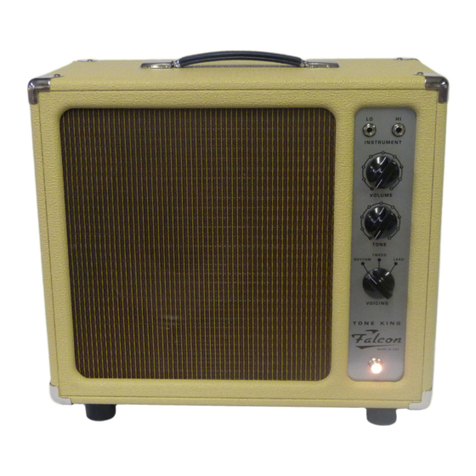
Tone King
Tone King FALCON User manual

Tone King
Tone King Falcon Grande User manual

Tone King
Tone King Tone King "Sky King" User manual

Tone King
Tone King Tone King "Sky King" User manual
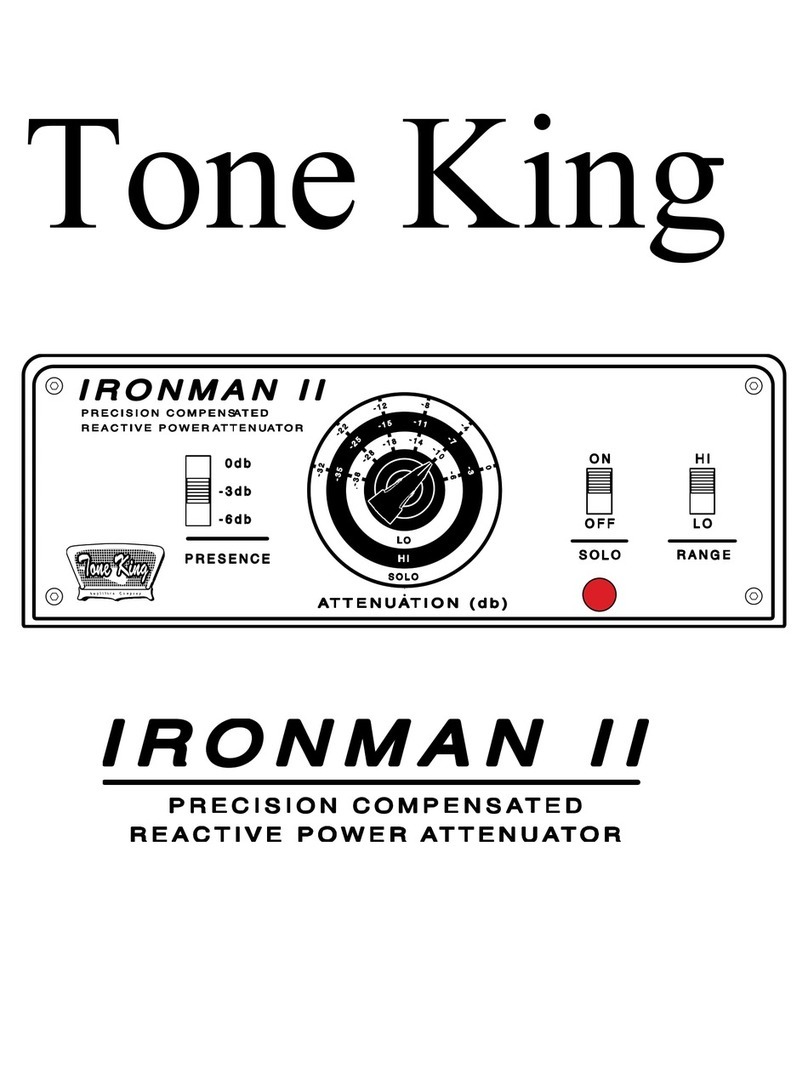
Tone King
Tone King Ironman II User manual

Tone King
Tone King Imperial MK II User manual
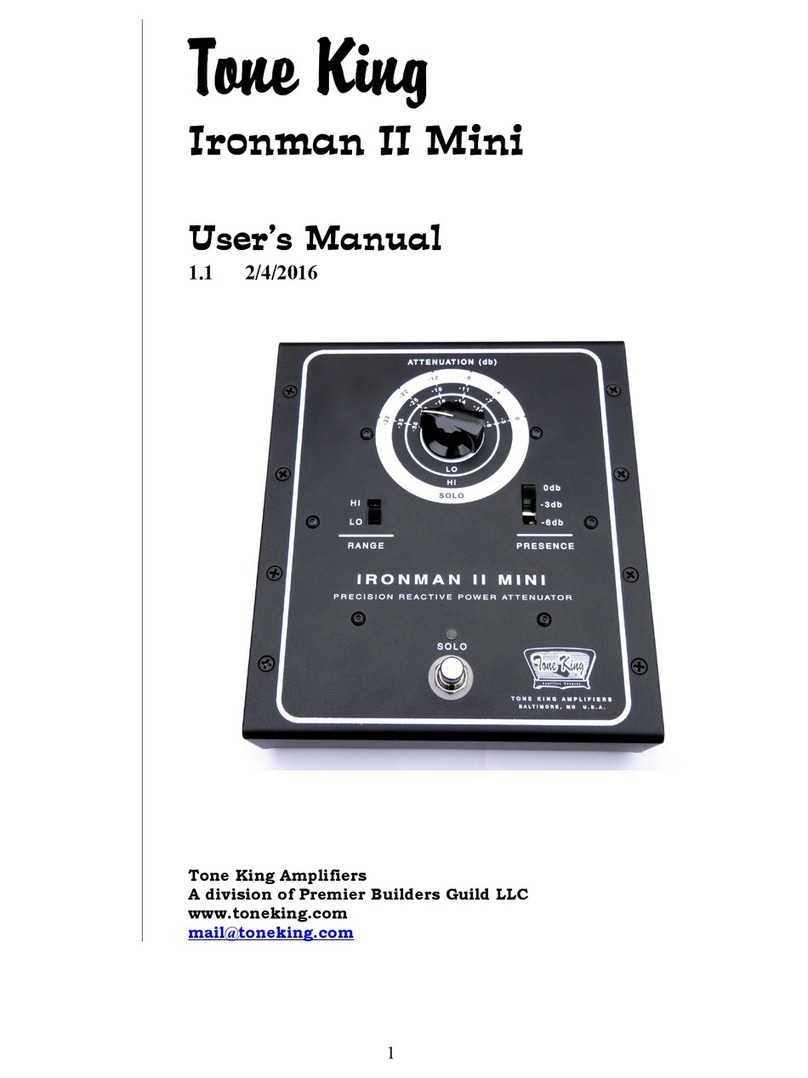
Tone King
Tone King Ironman II Mini User manual

Tone King
Tone King Falcon Grande User manual
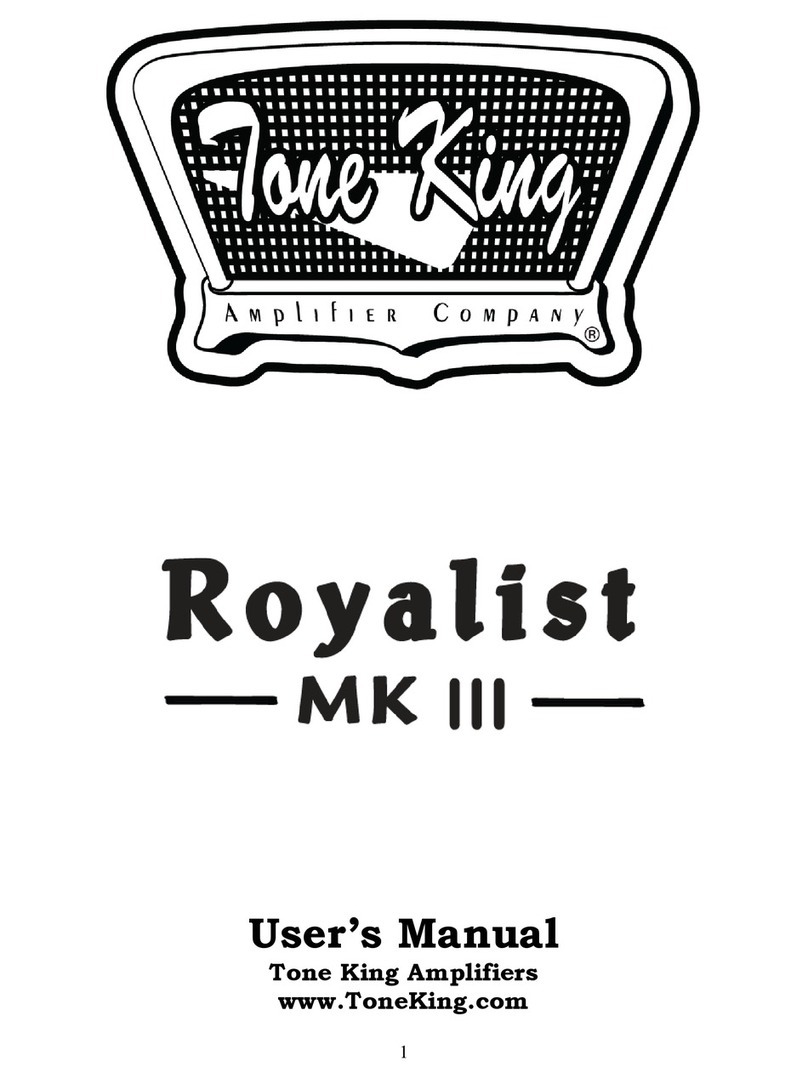
Tone King
Tone King Royalist MK III User manual

